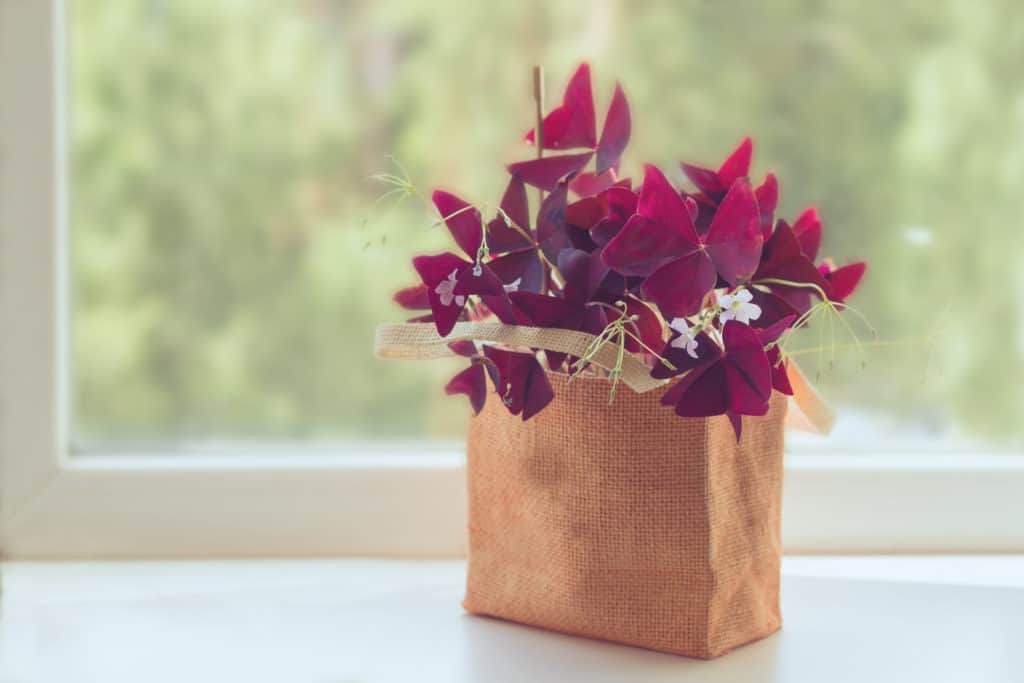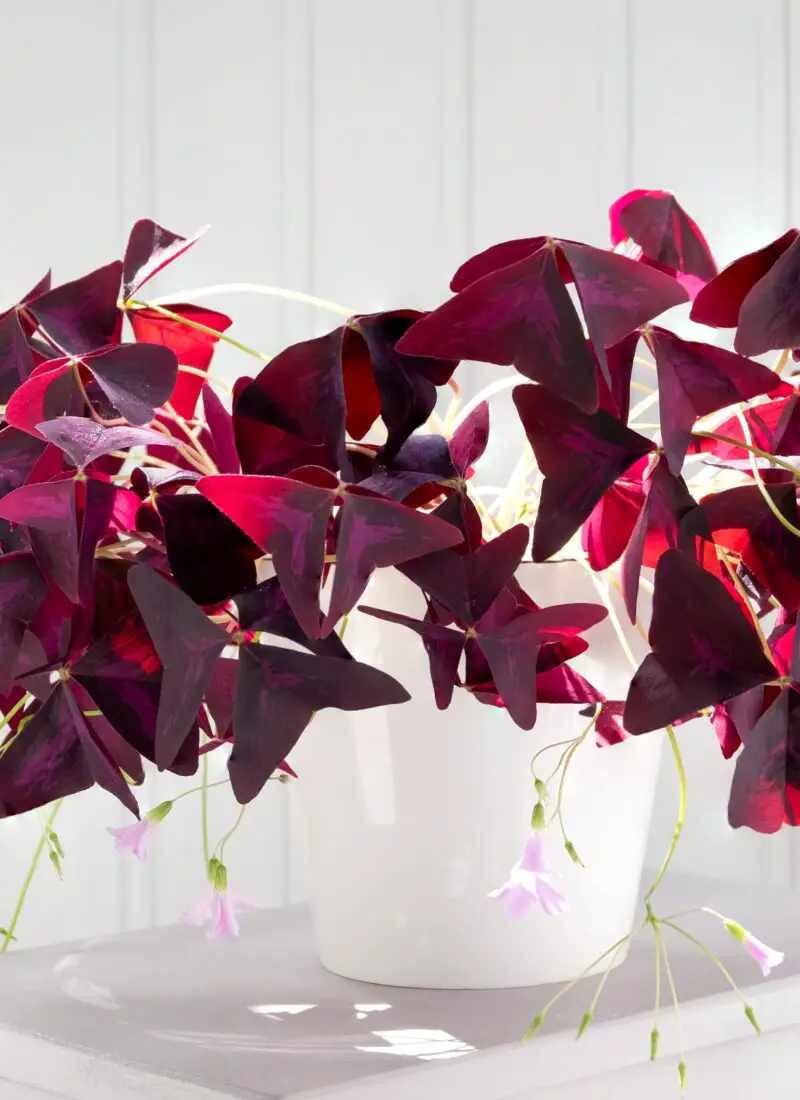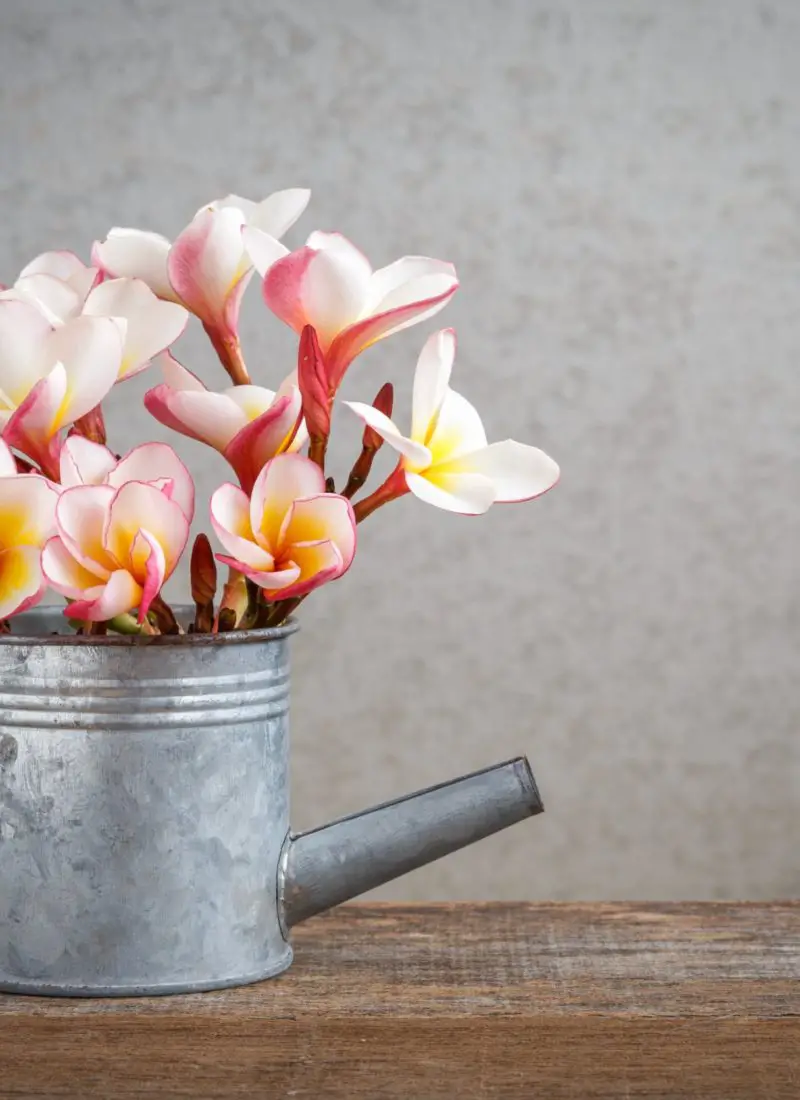
Oxalis Triangularis, aka Purple Shamrock, is a stunning plant with butterfly-shaped leaves and clusters of white flowers. So when you’re faced with the sudden drooping of the plant, you may be wondering “What went wrong?”
Take a deep breath and stay calm.
If you are unsure what drooping looks like then see the photo below, if it doesn’t look like that then check out this short part of our article on Oxalis Triangularis that talks about the natural (usually nightly) closing or folding of the leaves. If this is what you are seeing, this is not the same as drooping and your Oxalis is perfectly fine, its just sleeping 🙂
I promise even if your plant is drooping, it’s probably not that serious if you caught it early and, more likely, it’s the natural course of things and your plant is just hibernating:
(As an Amazon Associate, I earn from qualifying purchases.)
Table of contents
1. The Natural Dormancy Period

Seasonally, your oxalis will go through a challenging but necessary phase where it looks like it has given up on living, just like the soldiers who lost the Emu War (Wikipedia link). A hibernating Oxalis sheds all its foliage and dies back down to take a long rest. This is called its natural dormancy period. It typically happens in the late fall, nearing wintertime. For some, it could be as early as late summer.
They will first exhibit an overall wilting look, almost like a person trying to attempt a push-up or sit-up for the first time. Usually, you can just leave your oxalis to “die out” and remove the fallen leaves and stems, leaving behind bare soil with the root tubers still underneath.
You can also force it into dormancy by cutting the drooping foliage down to the soil level. Ensure to store the sleeping plant in a cool, dark place to rest for the next 1 ½ months or more. Soon enough, your plant will start to show new growth again.
Important note on watering: DO NOT water your oxalis at all during this dormancy stage. All it will do is sit in the soil and increase the risk of root rot on the resting root tubers. You can only start watering the plant just a bit when new sprouts start coming up.
If your plant is just hibernating great! and if you would like to know about more oxalis varieties, how to make your plant even healthier, or fuller – check out our article: Everything You Need to Know About the Fascinating Oxalis Triangularis
2. Overwatering or Underwatering

If it’s not time for the plant’s dormancy phase, chances are it’s a watering issue. Both overwatering and underwatering can cause drooping leaves in a Purple Shamrock. Most of the time, checking the soil is enough to determine the case. But the leaves will also show additional damages like the following:
- Overwatered Oxalis Triangularis will have mushy, soft, drooping leaves.
- Underwatered Oxalis Triangularis will have crisp, drooping foliage.
So how do you save an overwatered oxalis?
- Allow the soil to dry out first. The crucial point here is to avoid adding more water to your very wet oxalis. Keeping it in a warm area will allow the water to evaporate faster.
- Cut the more pronounced droopy foliage. It will help the oxalis redirect its energy to grow new stems as it recovers.
However, if the problem is quite extensive, you may need to repot the rhizomes in dry, fresh potting soil and cut down the entire leaves. Be warned that it may take a couple of weeks for the plant to start growing again from scratch. But this is a better alternative than waiting for the soil to dry out and prolonging the problem.
Which brings us to… how often should you water your oxalis? As a general rule, water oxalis every 4-5 days. This may vary according to regional climate and the plant’s size. A good rule of thumb is to always check the top 1-2 inches of the soil before watering. If it is dry, it is time to give the plant a thorough soak.
For underwatering issues, it’s easily fixable. All you need to do is water it deeply several times until excess water drains out. Soon, it will perk up and recover from its brief, depressing, drought period.
3. Lack of Sunlight or Sudden Change in Light Intensity

Oxalis prefers to have direct sunlight to grow well, but sometimes indoor lights may be insufficient for proper development. They will start developing leggy growth and look droopy, reaching for the nearest source of sunlight. Solution: rotate your plant to allow all sides an even sun exposure for uniform foliage growth.
You may be tempted to suddenly put your oxalis in a very bright area. Please don’t do this. This will actually backfire on you and make your plants worse off. The sudden light change and temperature spike from the sun’s glare will be too much of a shock. Not only that, if you leave your plant suffering at 27 degrees celsius for prolonged hours, it will force the plant to go into dormancy. Then we’re back to square one of the problem.
If you’re going to move your oxalis to a brighter area, do it gradually day by day. By doing this slowly, the plant will get used to it. Eventually, it will be bathing in the full sun and thriving happily.
And if you’re new to PHA and just need some pointers on houseplant care in general, check out our article: The 4 Basic But Very Important Elements of Houseplant Care
4. Transplant Shock from Repotting When It is Not in Dormancy

If you start to repot your oxalis in spring or summer before it is due to go dormant, chances are the plant will go into transplant shock. It will show its displeasure by displaying drooping leaves and a somewhat general sulky air around them. Even if you did the whole repotting procedure right and gave it ample water for its needs, it can’t be helped. Imagine getting dragged out of bed in the middle of the night and being told you are moving houses right then. Yup, your oxalis is not a happy camper.
There’s little you can do at this point. You just have to monitor the plant as it goes through these motions, and eventually, it’ll recover. Think of your oxalis as an unhappy teenager dragged to join a family event for the summer. They’ll come around sooner or later. When in doubt, water less than you think the plant needs, and check the soil regularly.
5. Disease Problems such as Rust

It’s pretty uncommon for oxalis to get disease problems unless one of your plants is infected with it already, we couldn’t even find pictures of diseased oxalis for our article, only mentions of it. One such thing that could affect your plant is Rust, which can also appear if you overwater your oxalis. If your plant is drooping and you see reddish-rust-colored fungal spots on the leaves, it is suffering from Rust.
Unfortunately, there’s no cure for this plant disease. But you can do the following to try saving your plant:
- Cut off the affected foliage with a sterilized cutting tool. Use alcohol wipes in between cuts to prevent transferring the pathogens.
- Quarantine your oxalis from other plants to prevent further infection.
- Optional: Apply fungicide on the plant to ensure the disease doesn’t spread. This may be a hit-or-miss because, as I’ve mentioned, there is no definite solution to getting rid of Rust completely.
- Give it the best care you can and monitor its recovery. Worse comes to worst, the plant will die off, and you’ll have to start with a new set of Oxalis Triangularis.
- Extra precaution: Identify any plants with similar symptoms. It’s vital to isolate any affected plants to prevent further contamination and let them recover.
If it isn’t rust but you’re pretty sure it is a pest or disease, take a look at another one of our articles: How to Rescue Plants from Common Houseplant Pests & Diseases for some other ideas that could help diagnose the issue.
Whatever your Oxalis Triangularis is suffering from, I really do hope you can revive it back. Otherwise, it’s probably just going to sleep before coming back again in full force. Happy planting!
References:
https://plants.ces.ncsu.edu/plants/oxalis-triangularis/
https://www.canr.msu.edu/news/the_care_and_feeding_of_purple_leaf_shamrocks
https://ipm.missouri.edu/MEG/2019/3/oxalis/
https://extension.psu.edu/shamrocks-as-houseplants
https://extension.psu.edu/shamrocks-myths-legends-folklore-and-facts







Leave a Reply